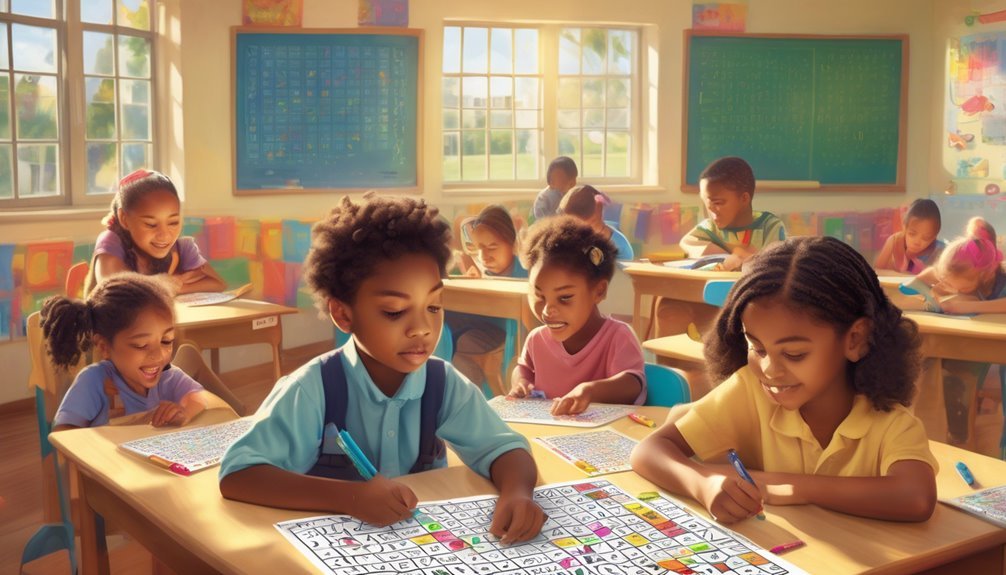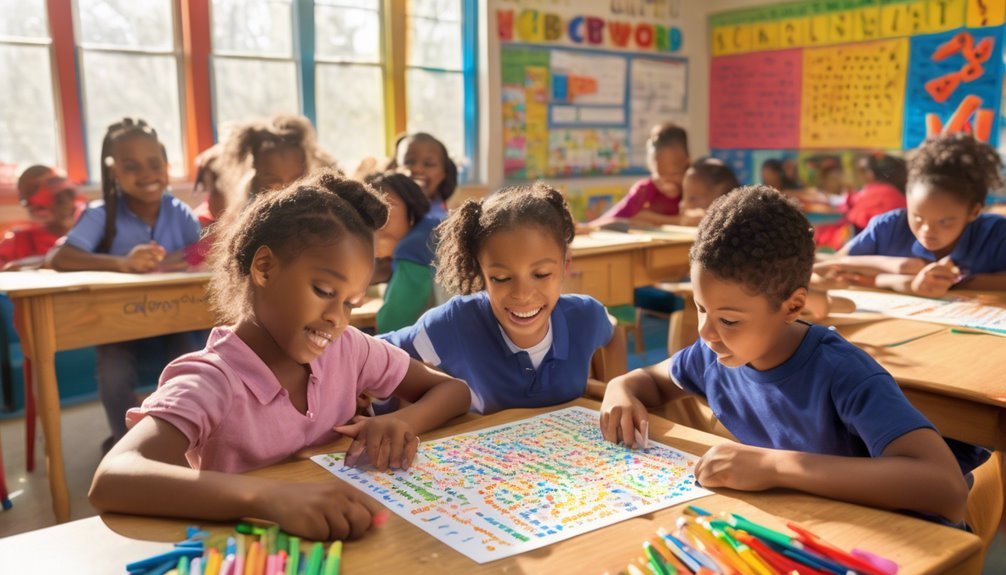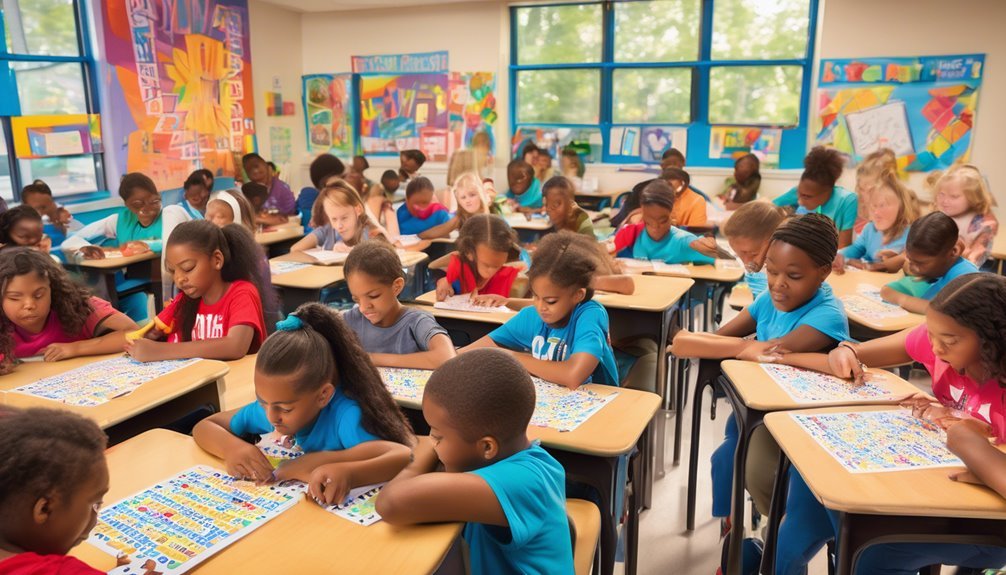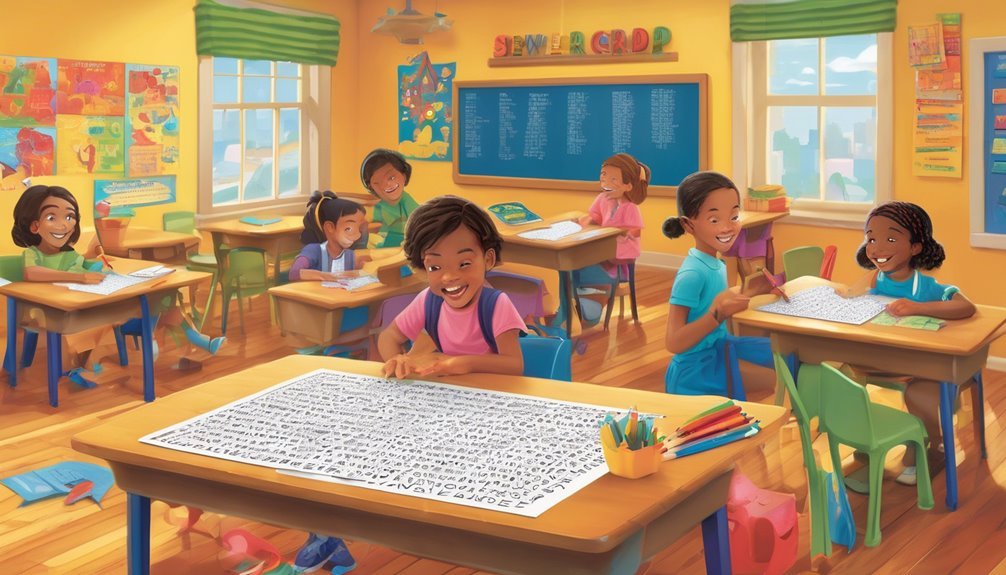Teaching CVC words through word search puzzles can be a transformative approach in your classroom. You’ll find that these puzzles not only engage students but also reinforce essential literacy skills. As you guide your students in discovering three-letter words, you’ll notice their confidence growing. But how do you design these puzzles effectively to maximize learning? The answer lies in understanding the best practices for implementation and engagement.
Key Takeaways
- Use simple CVC words in word searches to engage early readers and reinforce their understanding of basic language structure.
- Design manageable grid sizes to avoid overwhelming learners while maintaining an element of challenge with horizontal, vertical, and diagonal placements.
- Incorporate fun themes, like animals or objects, to spark interest and make the learning experience more enjoyable for students.
- Encourage collaboration by having students work in pairs, promoting idea sharing and enhancing their vocabulary-building experience.
- Review the words and their meanings together after completing the puzzle to reinforce understanding and boost confidence in using CVC words.
Understanding CVC Words and Their Importance

CVC words, or consonant-vowel-consonant words, are the building blocks of early reading and writing skills. When you introduce these simple words to your child, you’re opening a door to their literacy journey.
Think of how delightful it’s to watch them sound out “cat” or “dog” with excitement. These words help kids understand the basic structure of language, making reading feel less daunting. By mastering CVC words, they gain confidence and a sense of accomplishment.
As you work together, you’re not just teaching; you’re bonding over shared moments of discovery. You’ll find joy in their triumphs, and they’ll treasure the time spent with you, knowing they’re supported in this important phase of learning.
The Benefits of Word Search Puzzles in Education
While some might think of word search puzzles as mere games, they actually offer significant educational benefits. Engaging with these puzzles can sharpen your students’ focus and enhance their problem-solving skills. They also provide a fun way to reinforce vocabulary, making learning feel less daunting.
Here’s a quick look at some benefits:
| Benefit | Description | Impact on Learning |
|---|---|---|
| Vocabulary Building | Introduces new words in a playful way | Expands language skills |
| Critical Thinking | Encourages strategic thinking | Enhances cognitive abilities |
| Engagement | Makes learning enjoyable | Boosts motivation and interest |
Incorporating word searches into your lessons can create delightful learning experiences that resonate with your students.
How Word Searches Reinforce Letter Recognition

Word search puzzles not only build vocabulary but also play a key role in reinforcing letter recognition. As you navigate through the grid, you’re actively searching for letters, which sharpens your ability to identify them quickly. Each time you spot a letter, it reinforces its shape and sound in your mind.
You’ll notice how letters connect to form CVC words, creating a fun connection between recognition and meaning. Plus, the satisfaction of finding a word boosts your confidence and makes learning enjoyable.
Enhancing Vocabulary Through Word Search Activities
As you dive into word search activities, you’ll discover that they can significantly enhance your vocabulary. Each puzzle challenges you to find CVC words, reinforcing your understanding of each term. By repeatedly spotting these words, you’ll not only recognize them but also internalize their meanings.
You might even find yourself excitedly recalling words as you spot them, creating an engaging learning experience. It’s a fun way to explore language, and it encourages you to think about how these words fit into sentences and everyday conversations.
Plus, discovering new words can spark your curiosity, leading you to seek out more vocabulary and usage. So, embrace these puzzles—they’re a delightful path to enriching your language skills!
Designing Effective CVC Word Search Puzzles

To create effective CVC word search puzzles, start by selecting a range of simple, three-letter words that can engage learners. You’ll want to make the experience fun and educational.
Here are some tips to consider:
- Choose familiar CVC words like “cat,” “dog,” and “bat.”
- Keep the grid size manageable, so it’s not overwhelming.
- Include a mix of horizontal, vertical, and diagonal placements to challenge them.
- Use vibrant colors and playful fonts to make it visually appealing.
- Add a fun theme, like animals or objects, to spark interest.
Tips for Implementing Word Searches in the Classroom
Integrating word searches into your classroom can enhance students’ engagement while reinforcing their understanding of CVC words. To make the most of this activity, consider these tips:
| Tip | Description |
|---|---|
| Start Simple | Begin with fewer words for beginners. |
| Set Time Limits | Keep the activity focused and fun. |
| Encourage Pair Work | Let students collaborate and share ideas. |
| Use Themes | Choose topics that resonate with students’ interests. |
| Review After Completion | Discuss the words and their meanings together. |
Engaging Students With Creative Word Search Variations

Creative word search variations can make learning CVC words even more exciting for your students. By adding a personal touch, you’ll not only engage them but also create memorable learning experiences.
Here are some fun twists you can try:
- Theme-Based Searches: Focus on themes like animals or seasons to spark interest.
- Timed Challenges: Add a race against the clock to make it competitive.
- Collaborative Puzzles: Pair students to solve word searches together, promoting teamwork.
- Artistic Elements: Let students create their own word searches to share with classmates.
- Mystery Words: Incorporate clues for hidden words to add an element of surprise.
These variations can transform routine learning into an enjoyable adventure, helping your students connect with CVC words in a deeper way.
Assessing Student Progress With Word Searches
Assessing student progress with word searches can be an effective method to gauge understanding of CVC words. As your students engage with these puzzles, you’ll see how well they recognize and recall essential words. You can observe their confidence grow as they successfully find and circle each word.
After completing the puzzle, ask them to read the words aloud. This not only reinforces their learning but also gives you insight into their pronunciation and fluency. If they struggle with certain words, you’ll know where to focus your future lessons.
Creating a relaxed atmosphere around these activities encourages open communication, allowing students to express their thoughts and feelings about their learning journey.
You’ll foster a supportive environment that nurtures their growth.
Resources for Creating Custom CVC Word Searches

While you may already have a variety of CVC words in mind, finding the right tools to create custom word searches can enhance your teaching experience.
Here are some fantastic resources that can help you craft engaging puzzles for your students:
- Discovery Education’s Puzzlemaker: A user-friendly platform for generating puzzles.
- Word Search Labs: Easily create and share custom word searches online.
- Teachers Pay Teachers: Find pre-made word search templates tailored for CVC words.
- WordMint: A versatile tool for designing personalized word searches.
- Canva: Use this graphic design site to create visually appealing word searches.
These resources will make it simple to tailor your activities and keep your students excited about learning.
Enjoy the process!
Frequently Asked Questions
What Age Group Benefits Most From CVC Word Search Puzzles?
You’ll find that children aged 5 to 7 benefit most from CVC word search puzzles. They’re at a crucial stage, developing early reading skills, and these puzzles make learning fun and engaging for them.
How Can Parents Use Word Searches at Home?
Imagine a treasure hunt in your living room. You can create word searches together, turning learning into a playful adventure. As you solve puzzles, you’ll bond while helping your child discover the magic of words.
Are There Digital Tools for Creating Word Searches?
Absolutely! You can use digital tools like Discovery Education’s Puzzlemaker or WordMint. These platforms let you create personalized word searches easily, making it fun and engaging for you and your loved ones to enjoy together.
What Are Common Mistakes When Teaching CVC Words?
Are you unknowingly skipping crucial phonemic awareness? Common mistakes when teaching CVC words include focusing too much on memorization, neglecting practice in context, and not addressing individual learning paces. It’s essential to nurture their understanding.
How Can I Modify Puzzles for Different Learning Levels?
You can modify puzzles by adjusting word complexity, using visual cues for beginners, or adding themes. For advanced learners, incorporate synonyms or challenge them with timed activities to keep things engaging and tailored to their abilities.
Conclusion
Incorporating word search puzzles into your teaching toolkit is like planting seeds in a garden of literacy. As students search for CVC words, they’re not just finding letters but nurturing their love for reading and language. By making learning interactive and fun, you’re helping them grow their vocabulary and confidence. So, embrace this playful approach and watch your students thrive as they uncover the treasures hidden within those grids, blossoming into confident readers.




